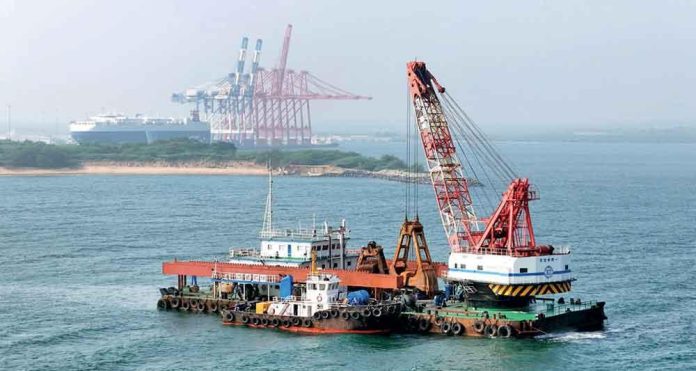The Hambantota International Port (HIP) began maintenance dredging operations this month to restore the port to its original depth.
The operation, carried out by HIP to ensure continued safe navigation of vessels, began in early February and is expected to be completed in approximately two months. The project will restore the port to its published specifications by rehabilitating its navigation channel and port basin.
Ports generally require regular maintenance dredging to prevent the gradual buildup of silt.
“The HIP’s navigation channel has a declared depth of 17 meters below sea level. However, over time, siltation has reduced this depth in certain locations. Regular maintenance dredging is essential to maintain operational efficiency and safety standards, hence the need to dredge and re-drain our declared depth. This will ensure that we continue to accommodate large vessels safely and efficiently,” said Captain Ravi Jayawickrama, CEO of Hambantota International Port Services (HIPS).
The port commenced the dredging operation following an extensive bathymetric survey to accurately map the current silt levels throughout the port. This survey enabled the project team to identify specific areas requiring dredging. Once the survey was completed, a tender process was called and the most suitable contractor was awarded the specific work.
HIPG Chief Specialist Engineer Datta Gunasekara said, “The bathymetric survey conducted with the Sri Lanka Navy Flood Service last year identified isolated patches of silted areas. The maintenance dredging operation was then planned with the necessary statutory approvals, further testing of water and sediment quality and precautions to ensure safe navigation, emergency preparedness and environmental protection. All necessary environmental permits for dredging and sea disposal at a location 11 nautical miles from the shore were obtained from CC&CRM, CEA and MEPA. The process is continuously monitored by HIP’s Port Control Unit to ensure safety and meet statutory requirements. The disposal activities, which will be carried out without any disruption to fishing activities in the neighbouring area, are a continuous operation with periodic stops to allow for safe ship movement. ”
Although the silt accumulation is considered to be within normal limits compared to other coastal locations in the country, Gunasekara said HIP has made it a priority to restore the declared depth of the port as soon as possible.
“The dredging contractor is using a state-of-the-art grab dredger to collect the silt and load it onto hopper barges. Although the daily operational dredging cycle at the port is usually two, we will adjust the schedule as necessary to accommodate incoming vessels and ensure their safe passage,” he added.





